Metal-Organic Frameworks for Wastewater Decontamination: Discovering Intellectual Structure and Research Trends
Abstract
:1. Introduction
| Type of Pollutants | MOFs | Adsorption Capacity (mg/g) | Remarks | Reference |
|---|---|---|---|---|
| Basic Red 46 | NH2-MIL-125(Ti) | 1296 | High reusability and stability over three cycles | [28] |
| Basic Blue 41 | NH2-MIL-125(Ti) | 1257 | High reusability and stability over three cycles | [28] |
| Cephalexin | PCN-777 | 442.48 | Suitable for wastewater consisting of traces of antibiotics | [29] |
| Ciprofloxacin (CIP) | Fe3O4/HKUST-1 | 538 | Fast adsorption rate, which could remove all the pollutants within 30 min | [30] |
| NPC-700 | 416.7 | Good recyclability | [31] | |
| ZIF-67 | 471.7 | Fast adsorption, due to the presence of hollow Co3S4 | [32] | |
| Congo Red (CR) | Fe-MIL-88NH2 | 167.5 | Endothermic process to remove CR from wastewater | [33] |
| [Ni2F2(4,4bipy)2 (H2O)2] (VO3)2 8H2O | 242.1 | Significant factors: the amount of adsorbent, Congo red concentration, and temperature | [34] | |
| Dimetridazole (DMZ) | MIL-53(Al) | 467.3 | The flexibility of MIL-53(Al)’s pores to enlarge as the concentration of DMZ increased, induced a high adsorption capacity | [35] |
| H2S | Cu-MOF | 98–199 | - | [36] |
| Hg2+ | [Cu3(BTC)2]n | 714.29 | Heavy metal removal | [37] |
| Melachite Green | MIL 100 (Fe) | 146 | - | [38] |
| ZIF8@SiO2@ MnFe2O4 | 1010.2 | Easy regeneration of magnetic adsorbent | [39] | |
| Methyl Orange (MO) | Cr-BDC@MIL-101 | 132 | As the pH of wastewater increases, the adsorption capacity of MIL-101 decreases; the large pore size of MIL-101 gave advantages to the adsorption capacity. | [40] |
| UiO-66 | 454 | Excellent at low pH | [41] | |
| ZIF-8@SiO2@ MnFe2O4 | 78.12 | Easy regeneration of magnetic adsorbent | [39] | |
| Methylene Blue (MB) | HKUST-1/GO | 3.5 | The concentration of MB produced a significant result in the adsorption capacity of HKUST-1/GO | [42] |
| NH2-MIL-125 (Ti) | 862 | High reusability and stability over three cycles | [28] | |
| Amino-MIL-101(Al) | 762 | High adsorption, due to the good synergy between the amino group and cationic dye MB | [43] | |
| Co-Fe-LDH@UiO-66-NH2 | 555.62 | High reusability, without any significant changes in the efficiency | [44] | |
| Naproxen and Clofibric Acid | MIL-101 | 312 | Fast adsorption compared to activated carbon, due to the large pore size of MIL-101 | [45] |
| Minocycline (MC) | Fe3O4@ MIL-68 (Al) | 248.05 | The original structure of MIL-68 (Al) remains the same | [46] |
| Nitrobenzene | CAU-1 | 970 | Easy regeneration | [47] |
| MIL-68 (Al) | 1130 | Easy regeneration | [47] | |
| Organophosphorus Pesticides | UiO-67 (Zr) | 537,360 | - | [48] |
| Oxytetracycline (OTC) | ED-MIL-101 | 325.7 | Strongly pH-dependent | [49] |
| Rhodamine 6G | MgFe2O4@MOF | 306.75 | Fast adsorption within 5 min | [50] |
| Rhodamine B | MgFe2O4@MOF | 219.78 | Fast adsorption within 5 min | [50] |
| Rocephin | MIL-101-NH2 MIL-101 | 277.8 204.08 | Higher adsorption due to the presence of amino groups | [51] |
| Tetracycline Hydrochloride (TC) | UiO-66-(OH)2/GO | 37.96 | Adsorption efficiency increased when the concentration of the solution was 20 mg/L | [52] |
2. Research Methodology
(TS = ((“metal organic framework”) OR (“metal organic frameworks”) OR (“metal-organic framework”) OR (“metal-organic frameworks”) OR (“porous coordination polymer”) OR (“porous coordination polymers”) OR (“porous coordination network”) OR (“porous coordination networks”))) AND TS = (“wastewater *” OR “effluent *”)
3. Results and Discussion
3.1. Publication Count
3.2. Citation Count
3.3. Author Demography
3.4. Countries and Organizations
3.5. Journals and Disciplines
3.6. Keyword Reoccurrence
3.7. Time Zone Analysis
4. Emerging Research Trends in the Use of MOF for Wastewater Treatment
5. Key Challenges Faced by MOF Application in Wastewater Treatment
5.1. Lack of Standardization and Quality Control
5.2. High Cost of Operation
5.3. Difficulties in Scaling Up the Process and Storage Issues
5.4. Lack of Durability
5.5. Limited Availability of Raw Materials for the Production of MOFs
6. Conclusions
Author Contributions
Funding
Institutional Review Board Statement
Informed Consent Statement
Data Availability Statement
Conflicts of Interest
References
- García-Ávila, F.; Avilés-Añazco, A.; Sánchez-Cordero, E.; Valdiviezo-Gonzáles, L.; Ordoñez, M.D.T. The challenge of improving the efficiency of drinking water treatment systems in rural areas facing changes in the raw water quality. S. Afr. J. Chem. Eng. 2021, 37, 141–149. [Google Scholar] [CrossRef]
- Sonune, A.; Ghate, R. Developments in wastewater treatment methods. Desalination 2004, 167, 55–63. [Google Scholar] [CrossRef]
- Mancl, K. Wastewater Treatment Principles and Regulations; Ohio State University: Columbus, OH, USA, 1996. [Google Scholar]
- Crini, G.; Lichtfouse, E. Advantages and disadvantages of techniques used for wastewater treatment. Environ. Chem. Lett. 2019, 17, 145–155. [Google Scholar] [CrossRef]
- Mohsenpour, S.F.; Hennige, S.; Willoughby, N.; Adeloye, A.; Gutierrez, T. Integrating micro-algae into wastewater treatment: A review. Sci. Total Environ. 2021, 752, 142168. [Google Scholar] [CrossRef] [PubMed]
- Chai, W.S.; Cheun, J.Y.; Kumar, P.S.; Mubashir, M.; Majeed, Z.; Banat, F.; Ho, S.-H.; Show, P.L. A review on conventional and novel materials towards heavy metal adsorption in wastewater treatment application. J. Clean. Prod. 2021, 296, 126589. [Google Scholar] [CrossRef]
- Ezugbe, E.O.; Rathilal, S. Membrane Technologies in Wastewater Treatment: A Review. Membranes 2020, 10, 89. [Google Scholar] [CrossRef] [PubMed]
- Kumar, P.; Bansal, V.; Kim, K.-H.; Kwon, E.E. Metal-organic frameworks (MOFs) as futuristic options for wastewater treatment. J. Ind. Eng. Chem. 2018, 62, 130–145. [Google Scholar] [CrossRef]
- Aragaw, T.A.; Bogale, F.M.; Aragaw, B.A. Iron-based nanoparticles in wastewater treatment: A review on synthesis methods, applications, and removal mechanisms. J. Saudi Chem. Soc. 2021, 25, 101280. [Google Scholar] [CrossRef]
- Rowsell, J.L.; Yaghi, O.M. Metal-organic frameworks: A new class of porous materials. Microporous Mesoporous Mater. 2004, 73, 3–14. [Google Scholar] [CrossRef]
- Li, S.-L.; Xu, Q. Metal-organic frameworks as platforms for clean energy. Energy Environ. Sci. 2013, 6, 1656–1683. [Google Scholar] [CrossRef]
- Furukawa, H.; Cordova, K.E.; O’Keeffe, M.; Yaghi, O.M. The Chemistry and Applications of Metal-Organic Frameworks. Science 2013, 341, 1230444. [Google Scholar] [CrossRef] [PubMed] [Green Version]
- Fan, W.; Zhang, X.; Kang, Z.; Liu, X.; Sun, D. Isoreticular chemistry within metal-organic frameworks for gas storage and separation. Coord. Chem. Rev. 2021, 443, 213968. [Google Scholar] [CrossRef]
- Chidambaram, A.; Stylianou, K.C. Electronic metal-organic framework sensors. Inorg. Chem. Front. 2018, 5, 979–998. [Google Scholar] [CrossRef]
- Zhao, X.; Wang, Y.; Li, D.S.; Bu, X.; Feng, P. Metal-organic frameworks for separation. Adv. Mater. 2018, 30, 1705189. [Google Scholar] [CrossRef] [PubMed]
- Li, D.; Xu, H.-Q.; Jiao, L.; Jiang, H.-L. Metal-organic frameworks for catalysis: State of the art, challenges, and opportunities. EnergyChem 2019, 1, 100005. [Google Scholar] [CrossRef]
- Chen, J.; Zhu, Y.; Kaskel, S. Porphyrin-Based Metal-Organic Frameworks for Biomedical Applications. Angew. Chemie Int. Ed. 2021, 60, 5010–5035. [Google Scholar] [CrossRef] [Green Version]
- Tchinsa, A.; Hossain, M.F.; Wang, T.; Zhou, Y. Removal of organic pollutants from aqueous solution using metal organic frameworks (MOFs)-based adsorbents: A review. Chemosphere 2021, 284, 131393. [Google Scholar] [CrossRef]
- Li, J.; Wang, H.; Yuan, X.; Zhang, J.; Chew, J.W. Metal-organic framework membranes for wastewater treatment and water regeneration. Coord. Chem. Rev. 2020, 404, 213116. [Google Scholar] [CrossRef]
- Gao, Q.; Xu, J.; Bu, X.-H. Recent advances about metal-organic frameworks in the removal of pollutants from wastewater. Co-ord. Chem. Rev. 2019, 378, 17–31. [Google Scholar] [CrossRef]
- Lu, W.; Wei, Z.; Gu, Z.-Y.; Liu, T.-F.; Park, J.; Park, J.; Tian, J.; Zhang, M.; Zhang, Q.; Iii, T.G.; et al. Tuning the structure and function of metal-organic frameworks via linker design. Chem. Soc. Rev. 2014, 43, 5561–5593. [Google Scholar] [CrossRef]
- Liu, X.; Shan, Y.; Zhang, S.; Kong, Q.; Pang, H. Application of metal organic framework in wastewater treatment. Green Energy Environ. 2022, 97, 507–512. [Google Scholar] [CrossRef]
- Yaghi, O.M. Crystalline Metal-Organic Microporous Materials. U.S. Patent 5,648,508, 15 July 1997. [Google Scholar]
- Joseph, L.; Jun, B.-M.; Jang, M.; Park, C.M.; Muñoz-Senmache, J.C.; Hernández-Maldonado, A.J.; Heyden, A.; Yu, M.; Yoon, Y. Removal of contaminants of emerging concern by metal-organic framework nanoadsorbents: A review. Chem. Eng. J. 2019, 369, 928–946. [Google Scholar] [CrossRef]
- Wang, C.-C.; Ho, Y.-S. Research trend of metal-organic frameworks: A bibliometric analysis. Scientometrics 2016, 109, 481–513. [Google Scholar] [CrossRef]
- Ho, Y.-S.; Fu, H.-Z. Mapping of metal-organic frameworks publications: A bibliometric analysis. Inorg. Chem. Commun. 2016, 73, 174–182. [Google Scholar] [CrossRef]
- Ogawa, T.; Iyoki, K.; Fukushima, T.; Kajikawa, Y. Landscape of Research Areas for Zeolites and Metal-Organic Frameworks Using Computational Classification Based on Citation Networks. Materials 2017, 10, 1428. [Google Scholar] [CrossRef] [PubMed] [Green Version]
- Oveisi, M.; Asli, M.A.; Mahmoodi, N.M. MIL-Ti metal-organic frameworks (MOFs) nanomaterials as superior adsorbents: Synthesis and ultrasound-aided dye adsorption from multicomponent wastewater systems. J. Hazard. Mater. 2018, 347, 123–140. [Google Scholar] [CrossRef] [PubMed]
- Zhao, Y.; Zhao, H.; Zhao, X.; Qu, Y.; Liu, D. Synergistic effect of electrostatic and coordination interactions for adsorption removal of cephalexin from water using a zirconium-based metal-organic framework. J. Colloid Interface Sci. 2020, 580, 256–263. [Google Scholar] [CrossRef] [PubMed]
- Wu, G.; Ma, J.; Li, S.; Guan, J.; Jiang, B.; Wang, L.; Li, J.; Wang, X.; Chen, L. Magnetic copper-based metal organic framework as an effective and recyclable adsorbent for removal of two fluoroquinolone antibiotics from aqueous solutions. J. Colloid Interface Sci. 2018, 528, 360–371. [Google Scholar] [CrossRef]
- Forner, A.; Vilana, R.; Bianchi, L.; Rodriguez-Lope, C.; Reig, M.; García-Criado, M.; Rimola, J.; Solé, M.; Ayuso, C.; Bru, C.; et al. Lack of arterial hypervascularity at contrast-enhanced ultrasound should not define the priority for diagnostic work-up of nodules <2 cm. J. Hepatol. 2015, 62, 150–155. [Google Scholar] [CrossRef]
- Liang, C.; Zhang, X.; Feng, P.; Chai, H.; Huang, Y. ZIF-67 derived hollow cobalt sulfide as superior adsorbent for effective adsorption removal of ciprofloxacin antibiotics. Chem. Eng. J. 2018, 344, 95–104. [Google Scholar] [CrossRef]
- Fu, J.; Zhang, Q.; Huang, B.; Fan, N.; Jin, R. A review on anammox process for the treatment of antibiotic-containing wastewater: Linking effects with corresponding mechanisms. Front. Environ. Sci. Eng. 2021, 15, 17. [Google Scholar] [CrossRef]
- Zolgharnein, J.; Farahani, S.D.; Bagtash, M.; Amani, S. Application of a new metal-organic framework of [Ni2F2(4,4′-bipy)2(H2O)2](VO3)2.8H2O as an efficient adsorbent for removal of Congo red dye using experimental design optimization. Environ. Res. 2020, 182, 109054. [Google Scholar] [CrossRef] [PubMed]
- Peng, Y.; Zhang, Y.; Huang, H.; Zhong, C. Flexibility induced high-performance MOF-based adsorbent for nitroimidazole antibiotics capture. Chem. Eng. J. 2018, 333, 678–685. [Google Scholar] [CrossRef]
- Petit, C.; Mendoza, B.; Bandosz, T.J. Hydrogen Sulfide Adsorption on MOFs and MOF/Graphite Oxide Composites. ChemPhysChem 2010, 11, 3678–3684. [Google Scholar] [CrossRef] [PubMed]
- Ke, F.; Qiu, L.-G.; Yuan, Y.-P.; Peng, F.-M.; Jiang, X.; Xie, A.-J.; Shen, Y.-H.; Zhu, J.-F. Thiol-functionalization of metal-organic framework by a facile coordination-based postsynthetic strategy and enhanced removal of Hg2+ from water. J. Hazard. Mater. 2011, 196, 36–43. [Google Scholar] [CrossRef] [PubMed]
- Shu, H.; Xiu, P. Metal-organic framework MIL-100 (Fe) for the adsorption of malachite green from aqueous soIution. J. Mater. Chem. 2012, 22, 7449–7455. [Google Scholar]
- Abdi, J.; Mahmoodi, N.M.; Vossoughi, M.; Alemzadeh, I. Synthesis of magnetic metal-organic framework nanocomposite (ZIF-8@SiO2@MnFe2O4) as a novel adsorbent for selective dye removal from multicomponent systems. Microporous Mesoporous Mater. 2019, 273, 177–188. [Google Scholar] [CrossRef]
- Haque, E.; Jun, J.W.; Jhung, S.H. Adsorptive removal of methyl orange and methylene blue from aqueous solution with a metal-organic framework material, iron terephthalate (MOF-235). J. Hazard. Mater. 2011, 185, 507–511. [Google Scholar] [CrossRef]
- Ahmadijokani, F.; Mohammadkhani, R.; Ahmadipouya, S.; Shokrgozar, A.; Rezakazemi, M.; Molavi, H.; Aminabhavi, T.M.; Arjmand, M. Superior chemical stability of UiO-66 metal-organic frameworks (MOFs) for selective dye adsorption. Chem. Eng. J. 2020, 399, 125346. [Google Scholar] [CrossRef]
- Li, L.; Liu, X.L.; Geng, H.Y.; Hu, B.; Song, G.W.; Xu, Z.S. A MOF/graphite oxide hybrid (MOF: HKUST-1) material for the adsorption of methylene blue from aqueous solution. J. Mater. Chem. A 2013, 1, 10292–10299. [Google Scholar] [CrossRef]
- Haque, E.; Lo, V.; Minett, A.I.; Harris, A.T.; Church, T.L. Dichotomous adsorption behaviour of dyes on an amino-functionalised metal-organic framework, amino-MIL-101(Al). J. Mater. Chem. A 2014, 2, 193–203. [Google Scholar] [CrossRef]
- Khajeh, M.; Oveisi, A.R.; Barkhordar, A.; Sorinezami, Z. Co-Fe-layered double hydroxide decorated amino-functionalized zirconium terephthalate metal-organic framework for removal of organic dyes from water samples. Spectrochim. Acta Part A Mol. Biomol. Spectrosc. 2020, 234, 118270. [Google Scholar] [CrossRef] [PubMed]
- Hasan, Z.; Jeon, J.; Jhung, S.H. Adsorptive removal of naproxen and clofibric acid from water using metal-organic frameworks. J. Hazard. Mater. 2012, 209–210, 151–157. [Google Scholar] [CrossRef] [PubMed]
- Zhang, Y.-Y.; Liu, Q.; Yang, C.; Wu, S.-C.; Cheng, J.-H. Magnetic aluminum-based metal organic framework as a novel magnetic adsorbent for the effective removal of minocycline from aqueous solutions. Environ. Pollut. 2019, 255, 113226. [Google Scholar] [CrossRef] [PubMed]
- Xie, L.; Liu, D.; Huang, H.; Yang, Q.; Zhong, C. Efficient capture of nitrobenzene from waste water using metal-organic frameworks. Chem. Eng. J. 2014, 246, 142–149. [Google Scholar] [CrossRef]
- Zhu, X.; Li, B.; Yang, J.; Li, Y.; Zhao, W.; Shi, J.; Gu, J. Effective Adsorption and Enhanced Removal of Organophosphorus Pesticides from Aqueous Solution by Zr-Based MOFs of UiO-67. ACS Appl. Mater. Interfaces 2015, 7, 223–231. [Google Scholar] [CrossRef] [PubMed]
- Hu, T.; Jia, Q.; He, S.; Shan, S.; Su, H.; Zhi, Y.; He, L. Novel functionalized metal-organic framework MIL-101 adsorbent for capturing oxytetracycline. J. Alloys Compd. 2017, 727, 114–122. [Google Scholar] [CrossRef]
- Tian, H.; Peng, J.; Lv, T.; Sun, C.; He, H. Preparation and performance study of MgFe2O4/metal-organic framework composite for rapid removal of organic dyes from water. J. Solid State Chem. 2018, 257, 40–48. [Google Scholar] [CrossRef]
- Zhao, X.; Wei, Y.; Zhao, H.; Gao, Z.; Zhang, Y.; Zhi, L.; Wang, Y.; Huang, H. Functionalized metal-organic frameworks for effective removal of rocephin in aqueous solutions. J. Colloid Interface Sci. 2018, 514, 234–239. [Google Scholar] [CrossRef]
- Sun, Y.; Chen, M.; Liu, H.; Zhu, Y.; Wang, D.; Yan, M. Adsorptive removal of dye and antibiotic from water with functionalized zirconium-based metal organic framework and graphene oxide composite nanomaterial Uio-66-(OH) 2/GO. Appl. Surf. Sci. 2020, 525, 146614. [Google Scholar] [CrossRef]
- Naseer, M.N.; Zaidi, A.A.; Dutta, K.; Wahab, Y.A.; Jaafar, J.; Nusrat, R.; Ullah, I.; Kim, B. Past, present and future of materials’ applications for CO2 capture: A bibliometric analysis. Energy Rep. 2022, 8, 4252–4264. [Google Scholar] [CrossRef]
- Goel, G.; Hélix-Nielsen, C.; Upadhyaya, H.M. A bibliometric study on biomimetic and bioinspired membranes for water filtration. NPJ Clean Water 2021, 4, 41. [Google Scholar] [CrossRef]
- Naseer, M.N.; Zaidi, A.A.; Khan, H.; Kumar, S.; bin Owais, M.T.; Jaafar, J.; Suhaimin, N.S.; Wahab, Y.A.; Dutta, K.; Asif, M.; et al. Mapping the field of microbial fuel cell: A quantitative literature review (1970–2020). Energy Rep. 2021, 7, 4126–4138. [Google Scholar] [CrossRef]
- Falagas, M.E.; Pitsouni, E.I.; Malietzis, G.; Pappas, G. Comparison of PubMed, Scopus, Web of Science, and Google Scholar: Strengths and weaknesses. FASEB J. 2007, 22, 338–342. [Google Scholar] [CrossRef] [PubMed]
- Pranckutė, R. Web of Science (WoS) and Scopus: The Titans of Bibliographic Information in Today’s Academic World. Publications 2021, 9, 12. [Google Scholar] [CrossRef]
- Naseer, M.N.; Zaidi, A.A.; Khan, H.; Kumar, S.; Bin Owais, M.T.; Wahab, Y.A.; Dutta, K.; Jaafar, J.; Uzair, M.; Johan, M.R.; et al. Desalination technology for energy-efficient and low-cost water production: A bibliometric analysis. Green Process. Synth. 2022, 11, 306–315. [Google Scholar] [CrossRef]
- Liu, W. The data source of this study is Web of Science Core Collection? Not enough. Scientometrics 2019, 121, 1815–1824. [Google Scholar] [CrossRef]
- Lim, M.K.; Li, Y.; Wang, C.; Tseng, M.-L. A literature review of blockchain technology applications in supply chains: A comprehensive analysis of themes, methodologies and industries. Comput. Ind. Eng. 2021, 154, 107133. [Google Scholar] [CrossRef]
- Kuppler, R.J.; Timmons, D.J.; Fang, Q.-R.; Li, J.-R.; Makal, T.A.; Young, M.D.; Yuan, D.; Zhao, D.; Zhuang, W.; Zhou, H.-C. Potential applications of metal-organic frameworks. Coord. Chem. Rev. 2009, 253, 3042–3066. [Google Scholar] [CrossRef]
- Ye, W.; Yang, W. Exploring metal-organic frameworks in electrochemistry by a bibliometric analysis. J. Ind. Eng. Chem. 2022, 109, 68–78. [Google Scholar] [CrossRef]
- Nagarkar, S.S.; Unni, S.M.; Sharma, A.; Kurungot, S.; Ghosh, S.K. Two-in-One: Inherent Anhydrous and Water-Assisted High Proton Conduction in a 3D Metal-Organic Framework. Angew. Chem. Int. Ed. 2014, 53, 2638–2642. [Google Scholar] [CrossRef] [PubMed]
- De Rosa, S.; Giordano, G.; Granato, T.; Katovic, A.; Siciliano, A.; Tripicchio, F. Chemical Pretreatment of Olive Oil Mill Wastewater Using a Metal-Organic Framework Catalyst. J. Agric. Food Chem. 2005, 53, 8306–8309. [Google Scholar] [CrossRef] [PubMed]
- Cychosz, K.A.; Matzger, A.J. Water Stability of Microporous Coordination Polymers and the Adsorption of Pharmaceuticals from Water. Langmuir 2010, 26, 17198–17202. [Google Scholar] [CrossRef] [PubMed]
- Rajbanshi, A.; Moyer, B.A.; Custelcean, R. Sulfate Separation from Hanford Waste Simulants by Selective Crystallization of Urea-Functionalized Capsules. Sep. Sci. Technol. 2012, 47, 2145–2150. [Google Scholar]
- Chen, X.; Ding, N.; Zang, H.; Yeung, H.; Zhao, R.-S.; Cheng, C.; Liu, J.; Chan, T.-W.D. Fe3O4@MOF core–shell magnetic microspheres for magnetic solid-phase extraction of polychlorinated biphenyls from environmental water samples. J. Chromatogr. A 2013, 1304, 241–245. [Google Scholar] [CrossRef]
- Erickson, M.D.; Kaley, R.G. Applications of polychlorinated biphenyls. Environ. Sci. Pollut. Res. 2011, 18, 135–151. [Google Scholar] [CrossRef]
- Peng, L.; Zhang, J.; Xue, Z.; Han, B.; Li, J.; Yang, G. Large-pore mesoporous Mn3O4 crystals derived from metal-organic frameworks. Chem. Commun. 2013, 49, 11695–11697. [Google Scholar] [CrossRef]
- Mao, G.; Liu, X.; Du, H.; Zuo, J.; Wang, L. Way forward for alternative energy research: A bibliometric analysis during 1994–2013. Renew. Sustain. Energy Rev. 2015, 48, 276–286. [Google Scholar] [CrossRef]
- Wang, C.-C.; Li, J.-R.; Lv, X.-L.; Zhang, Y.-Q.; Guo, G. Photocatalytic organic pollutants degradation in metal-organic frameworks. Energy Environ. Sci. 2014, 7, 2831–2867. [Google Scholar] [CrossRef]
- Wang, B.; Lv, X.-L.; Feng, D.; Xie, L.-H.; Zhang, J.; Li, M.; Xie, Y.; Li, J.-R.; Zhou, H.-C. Highly Stable Zr(IV)-Based Metal-Organic Frameworks for the Detection and Removal of Antibiotics and Organic Explosives in Water. J. Am. Chem. Soc. 2016, 138, 6204–6216. [Google Scholar] [CrossRef]
- Khan, N.A.; Hasan, Z.; Jhung, S.H. Adsorptive removal of hazardous materials using metal-organic frameworks (MOFs): A review. J. Hazard. Mater. 2013, 244–245, 444–456. [Google Scholar] [CrossRef] [PubMed]
- McDonald, T.M.; Mason, J.A.; Kong, X.; Bloch, E.D.; Gygi, D.; Dani, A.; Crocellà, V.; Giordanino, F.; Odoh, S.O.; Drisdell, W.S.; et al. Cooperative insertion of CO2 in diamine-appended metal-organic frameworks. Nature 2015, 519, 303–308. [Google Scholar] [CrossRef] [PubMed]
- Jiang, L.; Yuan, X.; Pan, Y.; Liang, J.; Zeng, G.; Wu, Z.; Wang, H. Doping of graphitic carbon nitride for photocatalysis: A reveiw. Appl. Catal. B Environ. 2017, 217, 388–406. [Google Scholar] [CrossRef]
- Wang, H.; Yuan, X.; Wu, Y.; Zeng, G.; Chen, X.; Leng, L.; Wu, Z.; Jiang, L.; Li, H. Facile synthesis of amino-functionalized titanium metal-organic frameworks and their superior visible-light photocatalytic activity for Cr(VI) reduction. J. Hazard. Mater. 2015, 286, 187–194. [Google Scholar] [CrossRef]
- Dias, E.; Petit, C. Towards the use of metal-organic frameworks for water reuse: A review of the recent advances in the field of organic pollutants removal and degradation and the next steps in the field. J. Mater. Chem. A 2015, 3, 22484–22506. [Google Scholar] [CrossRef] [Green Version]
- Liang, R.; Jing, F.; Shen, L.; Qin, N.; Wu, L. MIL-53(Fe) as a highly efficient bifunctional photocatalyst for the simultaneous reduction of Cr(VI) and oxidation of dyes. J. Hazard. Mater. 2015, 287, 364–372. [Google Scholar] [CrossRef]
- Sophia, A.C.; Lima, E.C. Removal of emerging contaminants from the environment by adsorption. Ecotoxicol. Environ. Saf. 2018, 150, 1–17. [Google Scholar] [CrossRef]
- Zhou, Y.; Lu, J.; Zhou, Y.; Liu, Y. Recent advances for dyes removal using novel adsorbents: A review. Environ. Pollut. 2019, 252, 352–365. [Google Scholar] [CrossRef]
- Shen, Y.; Ji, L.; Xie, Y.; Huang, G.; Li, X.; Huang, L. Research landscape and hot topics of rooftop PV: A bibliometric and network analysis. Energy Build. 2021, 251, 111333. [Google Scholar] [CrossRef]
- Mao, G.; Zou, H.; Chen, G.; Du, H.; Zuo, J. Past, current and future of biomass energy research: A bibliometric analysis. Renew. Sustain. Energy Rev. 2015, 52, 1823–1833. [Google Scholar] [CrossRef]
- Pesta, B.; Fuerst, J.; Kirkegaard, E.O.W. Bibliometric Keyword Analysis across Seventeen Years (2000–2016) of Intelligence Articles. J. Intell. 2018, 6, 46. [Google Scholar] [CrossRef] [PubMed] [Green Version]
- Ahmed, I.; Jhung, S.H. Composites of metal-organic frameworks: Preparation and application in adsorption. Mater. Today 2014, 17, 136–146. [Google Scholar] [CrossRef]
- Li, J.-R.; Kuppler, R.J.; Zhou, H.-C. Selective gas adsorption and separation in metal-organic frameworks. Chem. Soc. Rev. 2009, 38, 1477–1504. [Google Scholar] [CrossRef] [PubMed]
- Bergaoui, M.; Khalfaoui, M.; Awadallah-F, A.; Al-Muhtaseb, S. A review of the features and applications of ZIF-8 and its derivatives for separating CO2 and isomers of C3- and C4- hydrocarbons. J. Nat. Gas Sci. Eng. 2021, 96, 104289. [Google Scholar] [CrossRef]
- Tambat, S.N.; Sane, P.K.; Suresh, S.; Varadan, N.O.; Pandit, A.B.; Sontakke, S.M. Hydrothermal synthesis of NH2-UiO-66 and its application for adsorptive removal of dye. Adv. Powder Technol. 2018, 29, 2626–2632. [Google Scholar] [CrossRef]
- Menon, S.; Agarwal, H.; Shanmugam, V.K. Catalytical degradation of industrial dyes using biosynthesized selenium nanoparticles and evaluating its antimicrobial activities. Sustain. Environ. Res. 2021, 31, 2. [Google Scholar] [CrossRef]
- Wang, Q.; Gao, Q.; Al-Enizi, A.M.; Nafady, A.; Ma, S. Recent advances in MOF-based photocatalysis: Environmental remediation under visible light. Inorg. Chem. Front. 2020, 7, 300–339. [Google Scholar] [CrossRef]
- Tan, K.B.; Vakili, M.; Horri, B.A.; Poh, P.E.; Abdullah, A.Z.; Salamatinia, B. Adsorption of dyes by nanomaterials: Recent developments and adsorption mechanisms. Sep. Purif. Technol. 2015, 150, 229–242. [Google Scholar] [CrossRef]
- Li, Y.; Gao, C.; Jiao, J.; Cui, J.; Li, Z.; Song, Q. Selective Adsorption of Metal-Organic Framework toward Methylene Blue: Behavior and Mechanism. ACS Omega 2021, 6, 33961–33968. [Google Scholar] [CrossRef]
- Qiu, J.; Feng, Y.; Zhang, X.; Jia, M.; Yao, J. Acid-promoted synthesis of UiO-66 for highly selective adsorption of anionic dyes: Adsorption performance and mechanisms. J. Colloid Interface Sci. 2017, 499, 151–158. [Google Scholar] [CrossRef]
- Petit, C.; Bandosz, T.J. Exploring the coordination chemistry of MOF–graphite oxide composites and their applications as adsorbents. Dalton Trans. 2012, 41, 4027–4035. [Google Scholar] [CrossRef]
- Ahsan, A.; Jabbari, V.; Islam, T.; Turley, R.S.; Dominguez, N.; Kim, H.; Castro, E.; Hernandez-Viezcas, J.A.; Curry, M.L.; Lopez, J.; et al. Sustainable synthesis and remarkable adsorption capacity of MOF/graphene oxide and MOF/CNT based hybrid nanocomposites for the removal of Bisphenol A from water. Sci. Total Environ. 2019, 673, 306–317. [Google Scholar] [CrossRef] [PubMed] [Green Version]
- Chen, Y.; Bai, X.; Ye, Z. Recent Progress in Heavy Metal Ion Decontamination Based on Metal-Organic Frameworks. Nanomaterials 2020, 10, 1481. [Google Scholar] [CrossRef] [PubMed]
- Li, K.; Li, J.-J.; Zhao, N.; Ma, Y.; Di, B. Removal of Tetracycline in Sewage and Dairy Products with High-Stable MOF. Molecules 2020, 25, 1312. [Google Scholar] [CrossRef] [PubMed] [Green Version]
- Silva, A.R.O.D.S.; Salgado, D.R.; Nagem, L.P.L.; Castanheira, D.; Emmerick, I.C.M.; Lima, E.D.C. Increased use of antibiotics in the intensive care unit during coronavirus disease (COVID-19) pandemic in a brazilian hospital. Front. Pharmacol. 2021, 3615. [Google Scholar] [CrossRef] [PubMed]
- Wei, F.; Zhang, H.; Ren, Q.; Chen, H.; Yang, L.; Ding, B.; Yu, M.; Liang, Z. Removal of organic contaminants from wastewater with GO/MOFs composites. PLoS ONE 2021, 16, e0253500. [Google Scholar] [CrossRef] [PubMed]
- Qu, H.-J.; Huang, L.-J.; Han, Z.-Y.; Wang, Y.-X.; Zhang, Z.-J.; Wang, Y.; Chang, Q.-R.; Wei, N.; Kipper, M.J.; Tang, J.-G. A review of graphene-oxide/metal-organic framework composites materials: Characteristics, preparation and applications. J. Porous Mater. 2021, 28, 1837–1865. [Google Scholar] [CrossRef]
- Zhao, G.; Qin, N.; Pan, A.; Wu, X.; Peng, C.; Ke, F.; Iqbal, M.; Ramachandraiah, K.; Zhu, J. Magnetic Nanoparticles@Metal-Organic Framework Composites as Sustainable Environment Adsorbents. J. Nanomater. 2019, 2019, 1454358. [Google Scholar] [CrossRef]
- Lv, S.-W.; Cong, Y.; Chen, X.; Wang, W.; Che, L. Developing fine-tuned metal-organic frameworks for photocatalytic treatment of wastewater: A review. Chem. Eng. J. 2021, 433, 133605. [Google Scholar] [CrossRef]
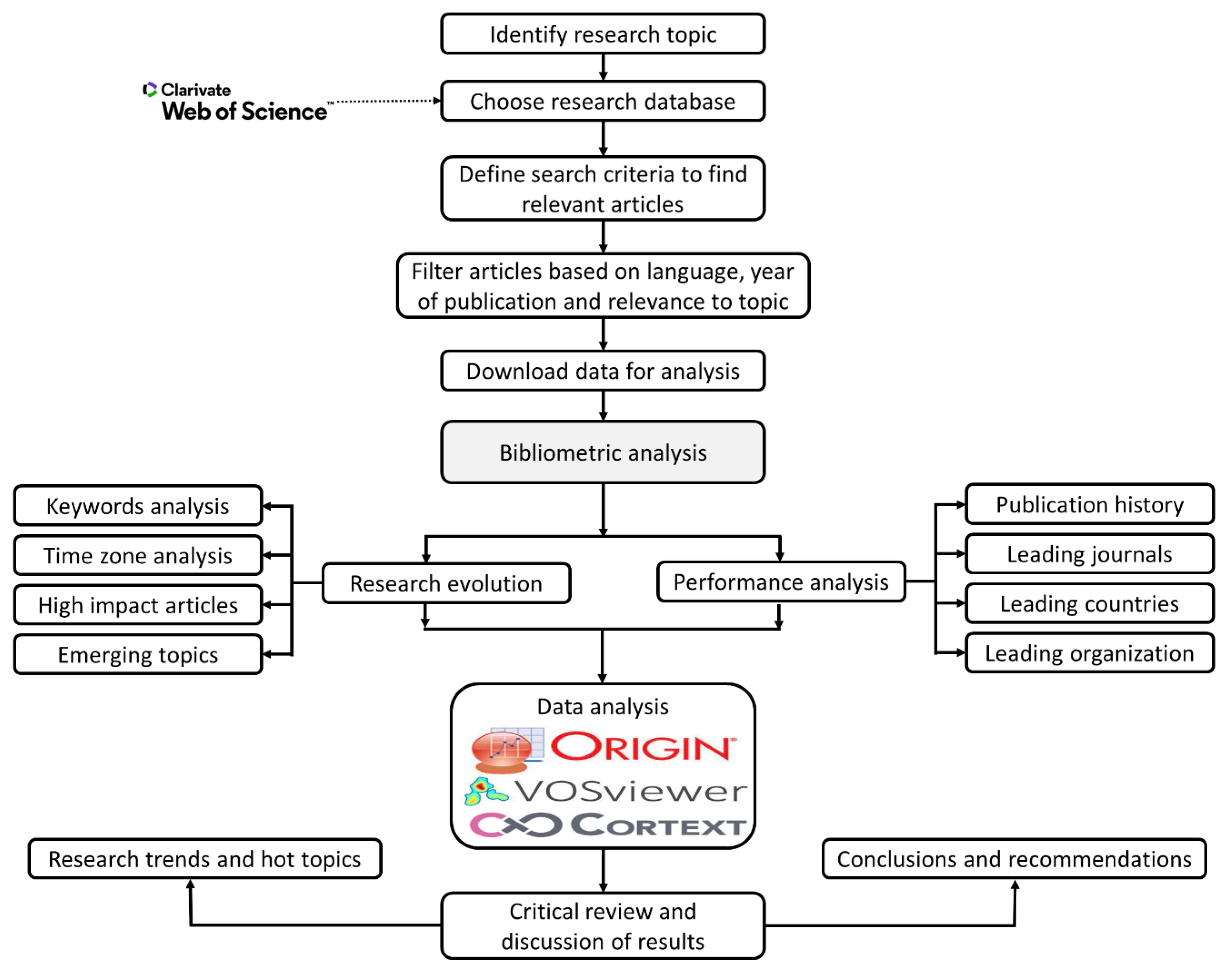
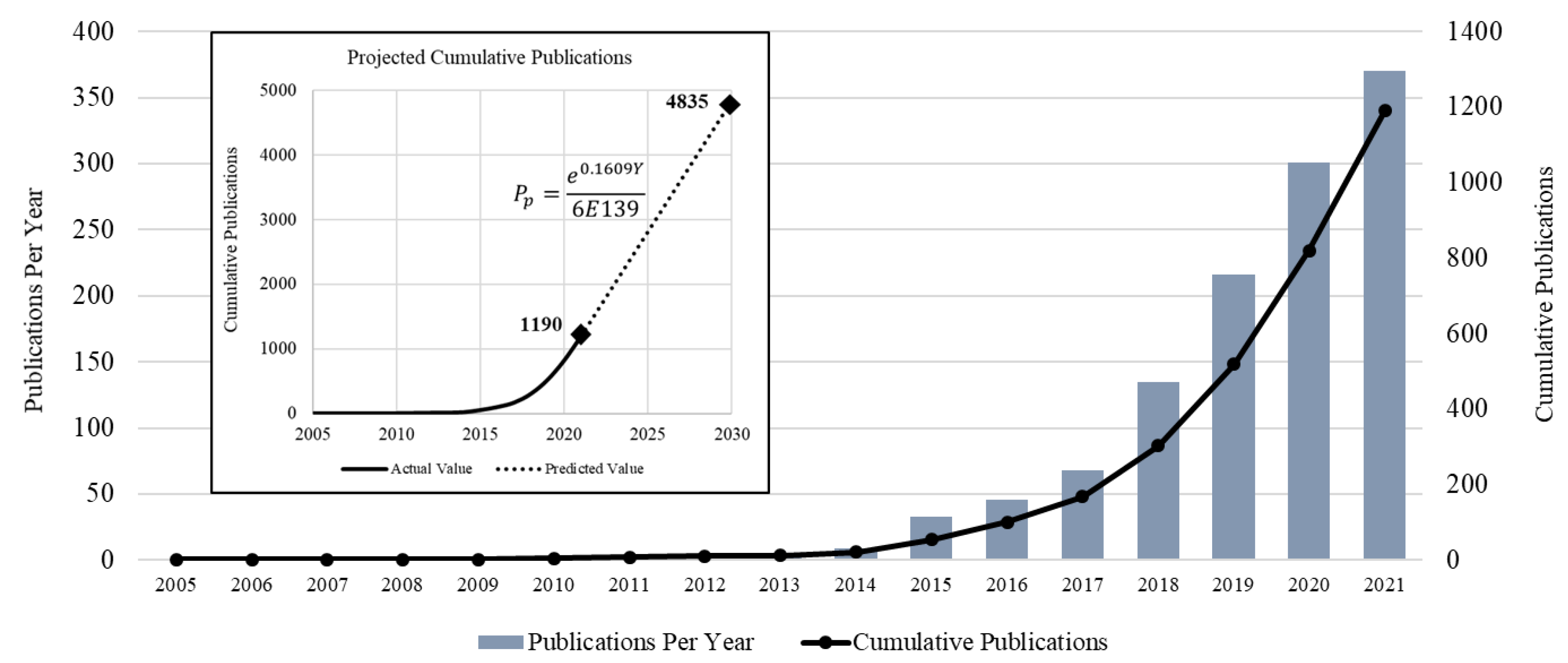
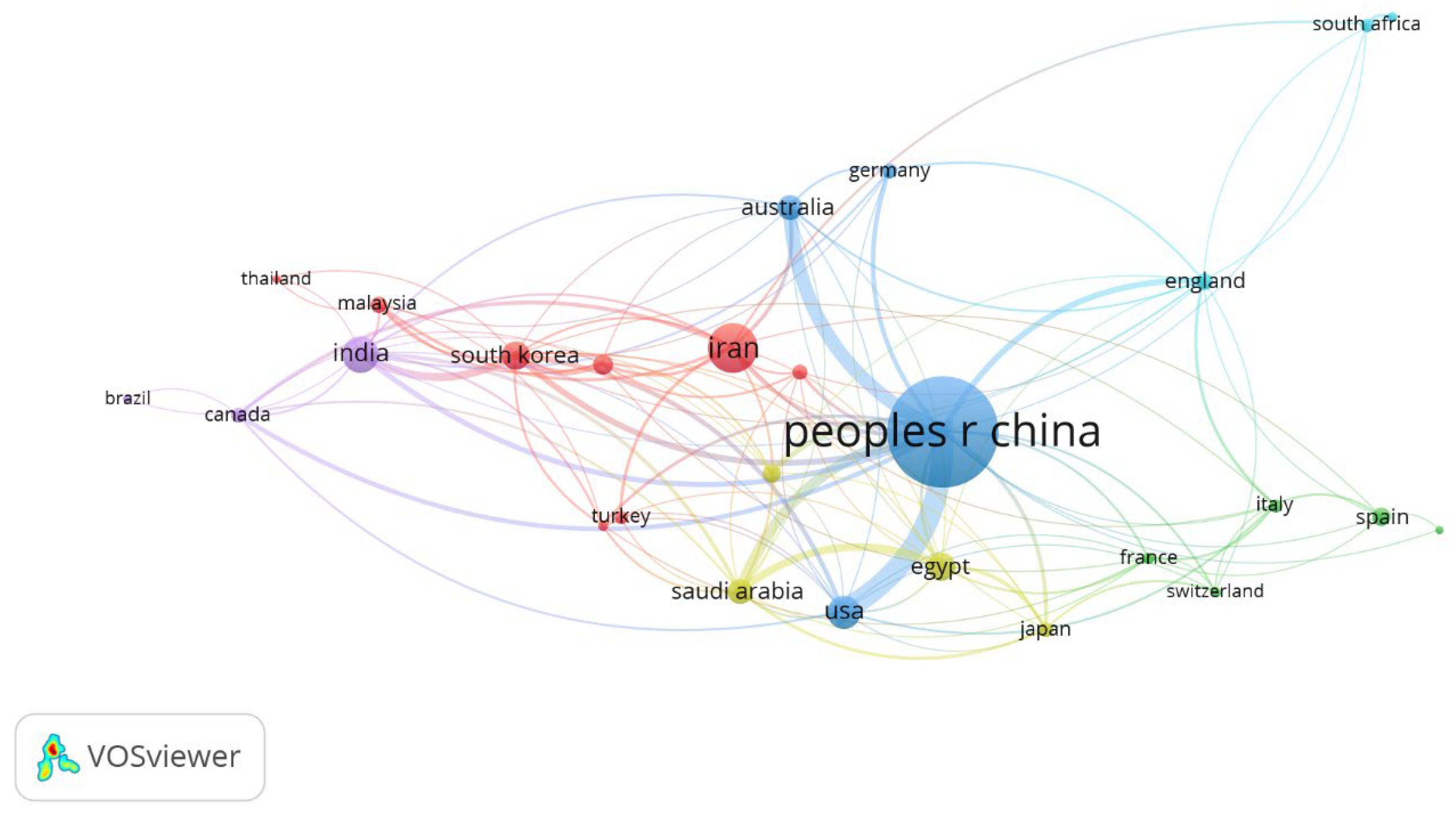
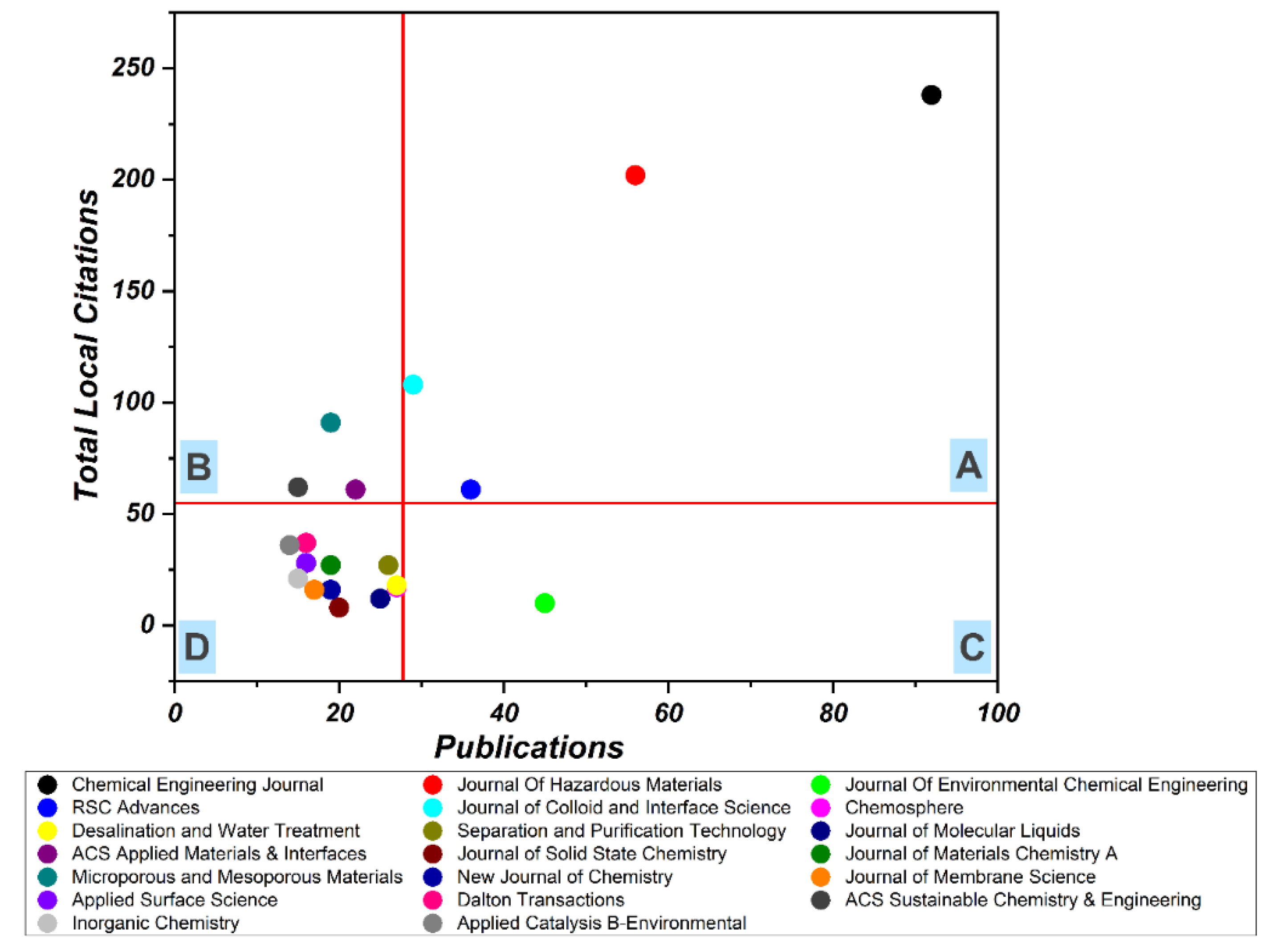
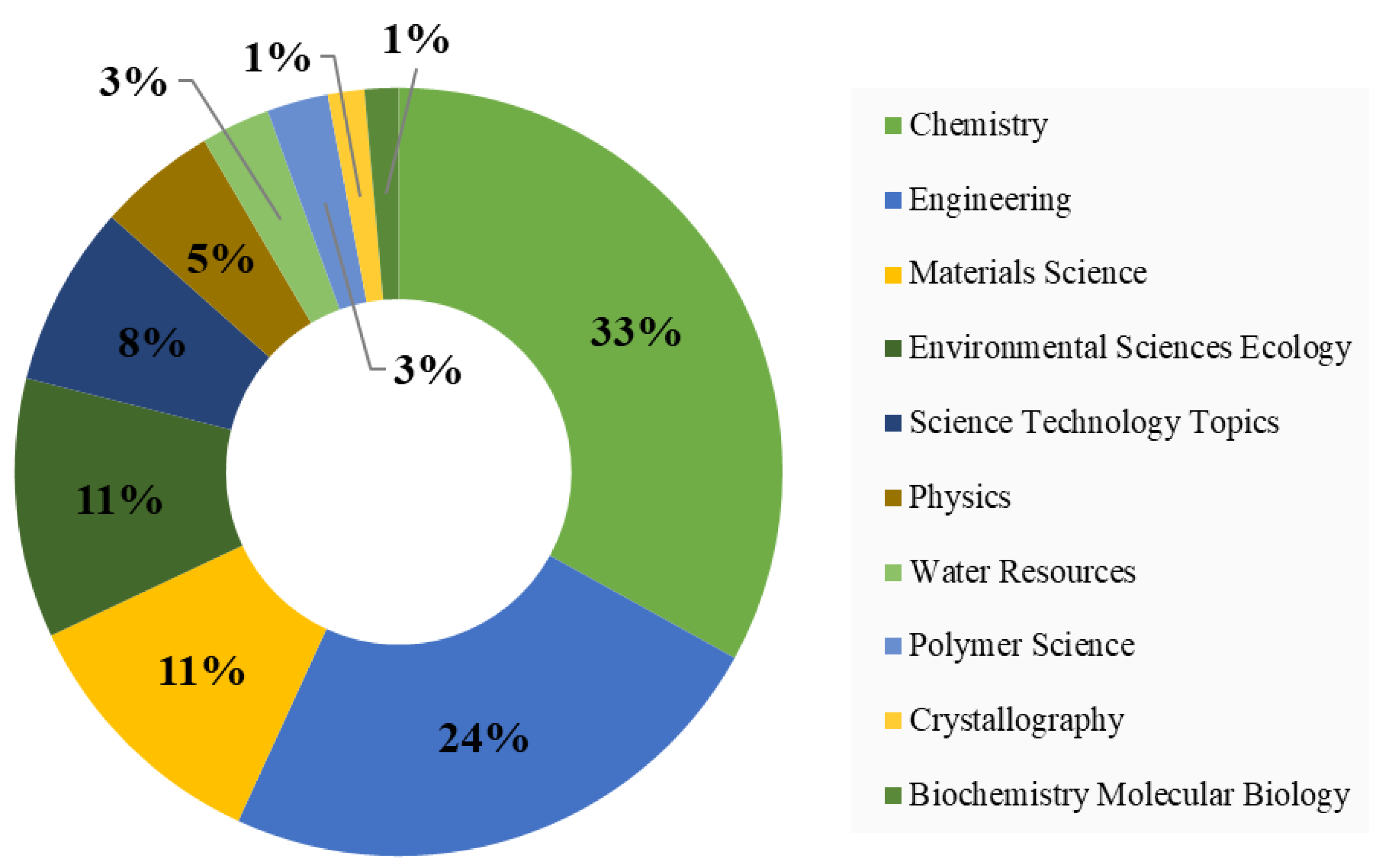
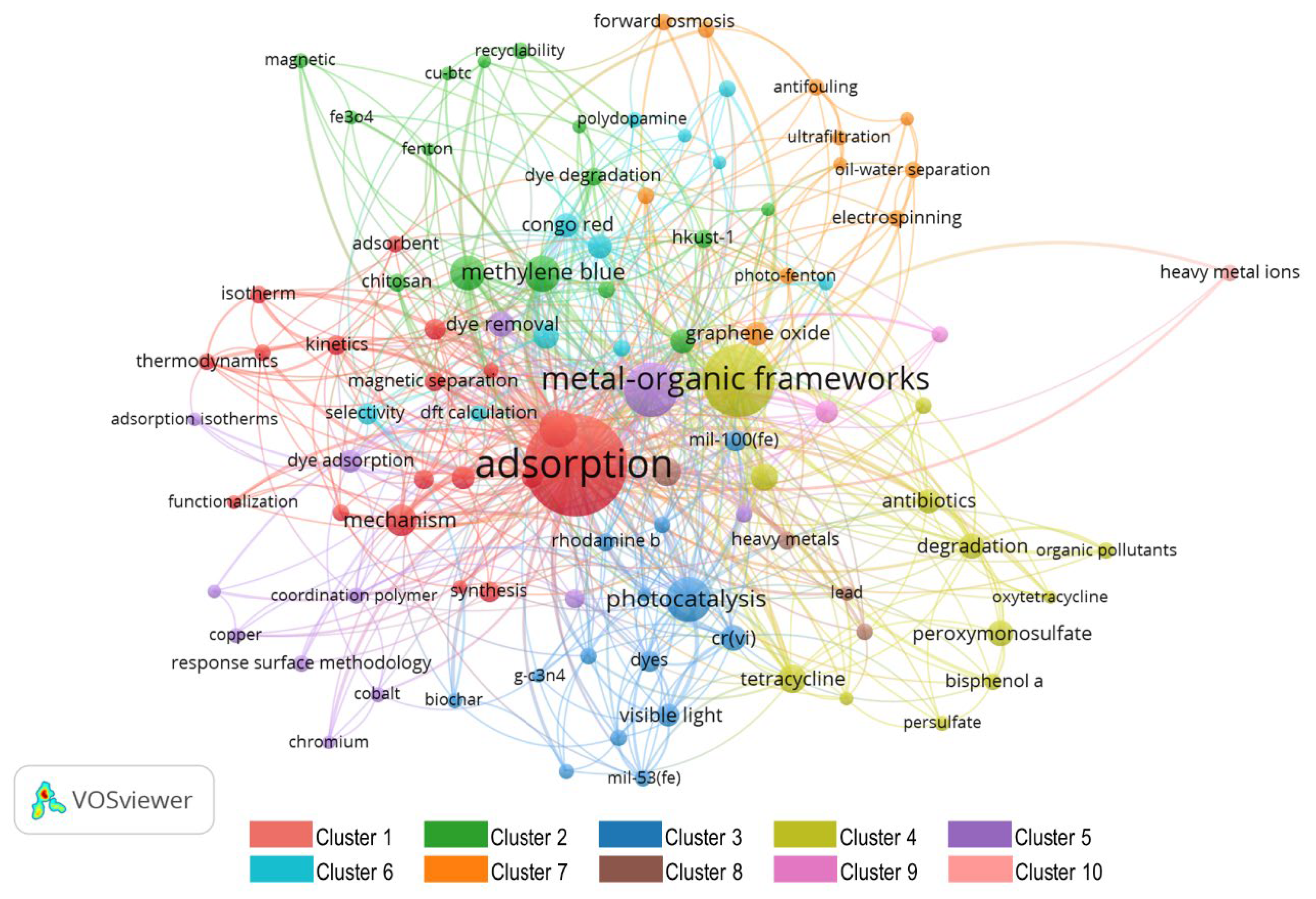
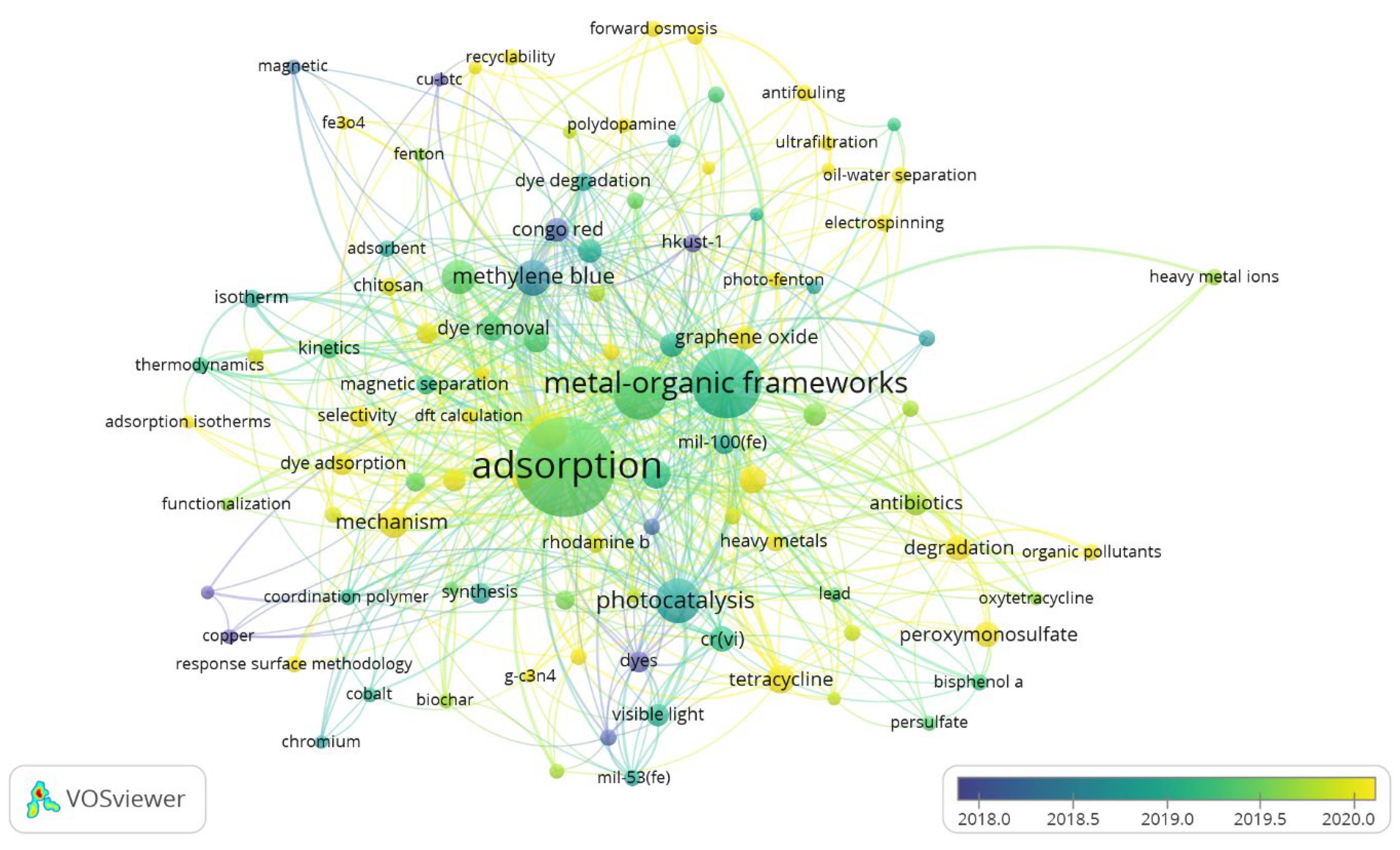
| Rank | Title | Ref. No. |
|---|---|---|
| 1 | Photocatalytic organic pollutants degradation in metal-organic frameworks | [71] |
| 2 | Highly Stable Zr(IV)-Based Metal-Organic Frameworks for the Detection and Removal of Antibiotics and Organic Explosives in Water | [72] |
| 3 | Adsorptive removal of hazardous materials using metal-organic frameworks (MOFs): A review | [73] |
| 4 | Cooperative insertion of CO2 in diamine-appended metal-organic frameworks | [74] |
| 5 | Doping of graphitic carbon nitride for photocatalysis: A review | [75] |
| 6 | Facile synthesis of amino-functionalized titanium metal-organic frameworks and their superior visible-light photocatalytic activity for Cr(VI) reduction | [76] |
| 7 | Towards the use of metal-organic frameworks for water reuse: a review of the recent advances in the field of organic pollutants removal and degradation and the next steps in the field | [77] |
| 8 | MIL-53(Fe) as a highly efficient bifunctional photocatalyst for the simultaneous reduction of Cr(VI) and oxidation of dyes | [78] |
| 9 | Removal of emerging contaminants from the environment by adsorption | [79] |
| 10 | Recent advances for dyes removal using novel adsorbents: A review | [80] |
| Authors | Publications | Citations | Organizations | Country | Research Area |
|---|---|---|---|---|---|
| Mahmoodi, Niyaz Mohammad | 16 | 924 | Institute for Color Science and Technology | Iran | Chemistry, Engineering, Wastewater Treatment |
| Wang, Peng | 12 | 376 | Shandong University | China | Chemistry, Engineering, Crystallography |
| Wang, Shixing | 12 | 256 | Nanjing University | China | Engineering, Environmental Ecology, Chemistry |
| Cao, Jiao | 11 | 515 | Hunan University | China | Chemistry, Engineering, Material Science |
| Huang, Hongliang | 10 | 352 | Tiangong University | China | Chemistry, Engineering, Material Science |
| Wang, Chen | 10 | 127 | Kunming Univ of Science and Technology | China | Chemistry, Engineering, Material Science |
| Xiong, Weiping | 10 | 331 | Hunan University | China | Chemistry, Engineering, Material Science |
| Hayat, Tasawar | 9 | 630 | King Abdulaziz University | Saudi Arabia | Engineering, Chemistry, Environmental Ecology |
| Wang, Chong-Chen | 9 | 352 | Beijing University of Chemical Technology | China | Engineering, Environmental Ecology, Chemistry |
| Wang, Yan | 9 | 181 | Hunan University | China | Engineering, Environmental Ecology, Chemistry |
| Rank | Country | Publication Contribution% | Citation Contribution% | Normalized Contribution |
|---|---|---|---|---|
| 1 | China | 61.16 | 48.04 | 0.50 |
| 2 | Iran | 12.38 | 6.57 | 1.75 |
| 3 | India | 6.57 | 4.10 | 0.06 |
| 4 | USA | 5.81 | 11.21 | 0.21 |
| 5 | South Korea | 4.13 | 2.97 | 0.96 |
| 6 | Egypt | 4.04 | 2.46 | 0.47 |
| 7 | Australia | 3.20 | 3.19 | 1.49 |
| 8 | Saudi Arabia | 3.20 | 3.11 | 1.09 |
| 9 | Vietnam | 2.11 | 0.64 | 0.26 |
| 10 | Spain | 1.77 | 0.93 | 0.45 |
| Rank | Organization | Country | Publication Contribution% | Citation Contribution% |
|---|---|---|---|---|
| 1 | Chinese Academy of Sciences | China | 5.14 | 18.81 |
| 2 | Hunan Univ. | China | 2.78 | 11.95 |
| 3 | Islamic Azad Univ. | Iran | 2.70 | 1.97 |
| 4 | Beijing Univ Chem. Tech. | China | 1.68 | 5.34 |
| 5 | Kunming Univ Sci. & Tech. | China | 1.68 | 2.60 |
| 6 | Soochow Univ | China | 1.68 | 6.26 |
| 7 | Nanjing Univ | China | 1.52 | 3.48 |
| 8 | South China Univ. Tech. | China | 1.52 | 2.25 |
| 9 | King Abdulaziz Univ. | Saudi Arabia | 1.43 | 4.23 |
| 10 | Tongji Univ. | China | 1.43 | 3.23 |
| Rank | Journal Name | Impact Factor | Document Contribution% | Citation Contribution% | Category |
|---|---|---|---|---|---|
| 1 | Chemical Engineering Journal | 13.273 | 14.13 | 22.49 | Engineering, Environmental Engineering, Chemical |
| 2 | Journal of Hazardous Materials | 10.588 | 8.60 | 15.17 | Engineering, Environmental Environmental Sciences |
| 3 | Journal of Environmental Chemical Engineering | 5.909 | 6.91 | 2.56 | Engineering, Environmental Engineering, Chemical |
| 4 | RSC Advances | 3.361 | 5.53 | 4.6 | Chemistry, Multidisciplinary |
| 5 | Journal of Colloid and Interface Science | 8.128 | 4.46 | 5.5 | Chemistry, Physical |
| 6 | Chemosphere | 7.086 | 4.15 | 2.58 | Environmental Sciences |
| 7 | Desalination and Water Treatment | 1.254 | 4.15 | 0.51 | Engineering, Chemical Water Resources |
| 8 | Separation and Purification Technology | 7.312 | 3.99 | 2.81 | Engineering, Chemical |
| 9 | Journal of Molecular Liquids | 6.165 | 3.84 | 1.95 | Chemistry, Physical Physics, Atomic, Molecular and Chemical |
| 10 | ACS Applied Materials & Interfaces | 9.229 | 3.38 | 3.66 | Materials Science, Multidisciplinary Nanoscience and Nanotechnology |
| Rank | Keywords | %Occurrence |
|---|---|---|
| 1 | Adsorption | 17.731 |
| 2 | Metal-Organic Frameworks | 8.967 |
| 3 | Wastewater Treatment | 5.163 |
| 4 | Photocatalysis | 3.668 |
| 5 | ZIF-8 | 2.446 |
| 6 | Methylene Blue | 2.310 |
| 7 | UiO-66 | 2.106 |
| 8 | Mechanism | 1.698 |
| 9 | Photocatalytic Degradation | 1.291 |
| 10 | Cr(VI) | 1.155 |
| 11 | Dye Removal | 1.155 |
| 12 | Peroxymonosulfate | 1.155 |
| 13 | Selective Adsorption | 1.155 |
| 14 | Antibiotics | 1.087 |
| 15 | Graphene Oxide | 1.087 |
Publisher’s Note: MDPI stays neutral with regard to jurisdictional claims in published maps and institutional affiliations. |
© 2022 by the authors. Licensee MDPI, Basel, Switzerland. This article is an open access article distributed under the terms and conditions of the Creative Commons Attribution (CC BY) license (https://creativecommons.org/licenses/by/4.0/).
Share and Cite
Naseer, M.N.; Jaafar, J.; Junoh, H.; Zaidi, A.A.; Kumar, M.; Alqahtany, A.; Jamil, R.; Alyami, S.H.; Aldossary, N.A. Metal-Organic Frameworks for Wastewater Decontamination: Discovering Intellectual Structure and Research Trends. Materials 2022, 15, 5053. https://doi.org/10.3390/ma15145053
Naseer MN, Jaafar J, Junoh H, Zaidi AA, Kumar M, Alqahtany A, Jamil R, Alyami SH, Aldossary NA. Metal-Organic Frameworks for Wastewater Decontamination: Discovering Intellectual Structure and Research Trends. Materials. 2022; 15(14):5053. https://doi.org/10.3390/ma15145053
Chicago/Turabian StyleNaseer, Muhammad Nihal, Juhana Jaafar, Hazlina Junoh, Asad A. Zaidi, Mahesh Kumar, Ali Alqahtany, Rehan Jamil, Saleh H. Alyami, and Naief A. Aldossary. 2022. "Metal-Organic Frameworks for Wastewater Decontamination: Discovering Intellectual Structure and Research Trends" Materials 15, no. 14: 5053. https://doi.org/10.3390/ma15145053
APA StyleNaseer, M. N., Jaafar, J., Junoh, H., Zaidi, A. A., Kumar, M., Alqahtany, A., Jamil, R., Alyami, S. H., & Aldossary, N. A. (2022). Metal-Organic Frameworks for Wastewater Decontamination: Discovering Intellectual Structure and Research Trends. Materials, 15(14), 5053. https://doi.org/10.3390/ma15145053










